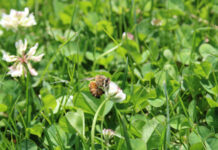
The U.S. Fish and Wildlife Service announced a plan to recover the endangered rusty patched bumble bee to prevent extinction and ensure its long-term future. “Saving a species from extinction is a group effort… we can’t do this alone” said Charlie Wooley, regional director for the Great Lakes Region of the USFWS. “This is a great opportunity for those who live in the range of the rusty patched bumble bee to get involved in recovery… We encourage everyone to help by learning more about this interesting bee and providing flowers for pollen and nectar.”
Rusty patched bumblebees are found in small, scattered populations in Illinois, Indiana, Iowa, Maine, Massachusetts, Minnesota, Ohio, Virginia, West Virginia, Wisconsin, and Ontario, Canada. Historically, the bee ranged across the eastern and upper Midwest U.S. Declared endangered in 2017, the bees’ population has plummeted by about 87% in the past two decades.
The cause of the species’ drastic decline is unknown, but evidence suggests an interaction between a disease-causing pathogen and exposure to pesticides. Other threats include habitat loss and degradation, competition and disease introduction from managed and non-native bees, small population genetics, and climate change.
The species needs nectar and pollen-producing flowers for food, undisturbed nesting habitat near food sources, and suitable overwintering areas to survive. The final recovery plan includes: land management to improve floral resources; measures to reduce exposure to pesticides and disease; and raising awareness.
Five things landscapers can do to help the rusty patched bumble bee (and other native bees!) include:
- Plant gardens with a variety of native flowers that bloom from early spring through fall, providing a food source for bumble bees.
- Convince clients to keep dandelions around – they’re an important early food source for the bee.
- Be conservative with pesticides – use only when necessary, and only as directed.
- Talk to clients about retaining garden debris in the fall. Rusty patched bumble bee queens overwinter in loose plant matter on the surface of the ground.
- Be on the lookout for nests and sightings! Many reports of nests are from citizens who find them in yards or natural areas.For more information on identifying the rusty patched bumble bee and conservation efforts, click here.











![[VIDEO] Dickies®: Discover Workwear That’s Anything But Uniform](https://turfmagazine.com/wp-content/uploads/2023/06/1647663814-4b1a2a7742790a9b1e97a3b963477850192e1d6a9dfba9b07214a77bae25d6e3-d-218x150.jpg)


























![[VIDEO] Dickies®: Discover Workwear That’s Anything But Uniform](https://turfmagazine.com/wp-content/uploads/2023/06/1647663814-4b1a2a7742790a9b1e97a3b963477850192e1d6a9dfba9b07214a77bae25d6e3-d-324x160.jpg)